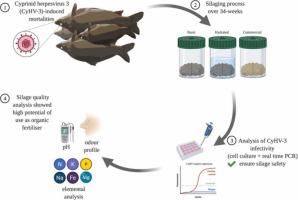Aquaculture Reports ( IF 3.2 ) Pub Date : 2022-04-08 , DOI: 10.1016/j.aqrep.2022.101116 Remigiusz Panicz 1 , Piotr Eljasik 1 , Agnieszka Troszok 2 , Małgorzata Sobczak 1 , Sławomir Lisiecki 1 , Arkadiusz Nędzarek 3 , Jacek Sadowski 3

|
In open farming systems, fish losses are unfortunate daily finding, hence a simple, safe and highly adaptable method is needed to manage dead fish. The aim of this study was to develop three silaging methods of common carp (Cyprinus carpio) carcasses to identify cost-effective, eco-friendly, and efficient method to turn dead fish into organic fertiliser and to determine whether Cyprinid herpesvirus 3 (CyHV-3) can be inactivated during a 34-weeks trial. In our study, dead fish were chopped, minced and mixed with starter bacteria culture and wheat bran (Basic), water and wheat bran starter (Hydrated) or Bokashi commercial mix (Commercial), and placed in a 1 L jars (in quadruplicates). The CyHV-3 infectivity potential was assessed by two cell cultures and expression of the virus genes classified into three temporal kinetic classes. The feasibility of the silaging method and selection of the best method assessed by pH monitoring, characterisation of the odour profile, elemental analysis and calculating the cost of the in-farm silaging. Cell cultures and the subsequent gene expression analyses showed that the virus was successfully inactivated in the Basic, Hydrated and Commercial silages, confirming their safety. Among the three silaging methods, the Hydrated was the cost-effective one; however, concerning the other features (odour profile, feasibility and final pH level), the Basic was selected as the most promising for implementation. Additionally, elemental analysis showed that the level of nutrients in Basic silage was higher than in commonly used natural fertilisers, while the content of heavy metals (Pb, Cd, Zn) met the official recommendations for organic fertilisers. The study provides premise of an effective method of silaging of dead carp that offers pathogen inactivation (via combination of decreased pH and microbial activity), turns common by-stream into a valuable product and increases profitability of the farm in a sustainable and cost-effective way.
中文翻译:

青贮工艺安全管理鲤鱼疱疹病毒3型鲤鱼(Cyprinus carpio)死亡
在开放式养殖系统中,鱼的损失是不幸的日常发现,因此需要一种简单、安全且适应性强的方法来管理死鱼。本研究的目的是开发三种青贮鲤鱼(Cyprinus carpio) 尸体,以确定将死鱼转化为有机肥料的成本效益、生态友好和有效的方法,并确定是否可以在 34 周的试验期间灭活 Cyprinid herpesvirus 3 (CyHV-3)。在我们的研究中,将死鱼切碎、切碎并与发酵剂细菌培养物和麦麸(基本)、水和麦麸发酵剂(水合)或 Bokashi 商业混合物(商业)混合,然后放入 1 L 罐中(一式四份) . CyHV-3 感染潜力通过两种细胞培养物和分类为三个时间动力学类别的病毒基因的表达来评估。通过 pH 监测、气味特征表征、元素分析和计算农场青贮成本来评估青贮方法的可行性和最佳方法的选择。细胞培养和随后的基因表达分析表明,病毒在碱性、水合和商业青贮饲料中成功灭活,证实了它们的安全性。在三种青贮方法中,水合是最划算的一种;然而,关于其他特性(气味特征、可行性和最终 pH 值),Basic 被选为最有希望实施的。此外,元素分析表明,碱性青贮饲料中的养分含量高于常用天然肥料,而重金属(Pb、Cd、Zn)含量符合官方有机肥推荐标准。该研究提供了一种有效的死鲤青贮方法的前提,该方法提供病原体灭活(通过降低 pH 值和微生物活性的组合),











































 京公网安备 11010802027423号
京公网安备 11010802027423号